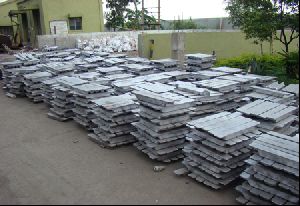
Get Price Quote
Anatase Titanium Dioxide Powder

Copper Wire Scrap
250 - 300 Per Kilogram
10 Metric Ton (MOQ)
Best Deals from Metal Scrap

Lead Scrap
Get Price Quote
Like copper, lead has also been a familiar metal used by human beings since ancient times. Lead, a highly malleable and easy to melt metal, is widely used in various industries even today. However, due to its highly toxic nature, the use of lead has been facing pressure from environmentalists in recent years.

Lead Scrap
Get Price Quote
Like copper, lead has also been a familiar metal used by human beings since ancient times. Lead, a highly malleable and easy to melt metal, is widely used in various industries even today. However, due to its highly toxic nature, the use of lead has been facing pressure from environmentalists in recent years. The pressure to end manufacture of lead-based paints is an example of the growing concern on the potential health hazards caused by lead. Plastics, aluminum, tin, and iron are replacing the use of lead in construction materials, containers, packaging, etc. Tin and other metals are being used to replace lead as a solder in some applications where lead could poison people, such as in drinking water systems. Lead is a very corrosion-resistant, dense, ductile, and malleable blue-gray metal that has been used for at least 5,000 years. Early uses of lead included building materials, pigments for glazing ceramics, and pipes for transporting water. The castles and cathedrals of Europe contain considerable quantities of lead in decorative fixtures, roofs, pipes, and windows. Prior to the early 1900's, uses of lead in the United States were primarily for ammunition, brass, burial vault liners, ceramic glazes, leaded glass and crystal, paints or other protective coatings, pewter, and water lines and pipes. The advent of the electrical age and communications, which were accelerated by technological developments in World War I, resulted in the addition of bearing metals, cable covering, caulking lead, solders, and type metal to the list of lead uses. With the growth in production of public and private motorized vehicles and the associated use of starting-lighting-ignition (SLI) lead-acid storage batteries and terne metal for gas tanks after World War I, demand for lead increased.Most of these uses for lead continued to increase with the growth in population and the national economy. Contributing to the increase in demand for lead was the use of lead as radiation shielding in medical analysis and video display equipment and as an additive in gasoline. By the mid-1980's, a significant shift in lead end-use patterns had taken place. Much of this shift was a result of the U.S. lead consumers compliance with environmental regulations that significantly reduced or eliminated the use of lead in nonbattery products, including gasoline, paints, solders, and water systems. More recently, as the use of lead in non-battery products has continued to decline, the demand for lead in SLI-type batteries has continued to grow. In addition, the demand for lead in non-SLI battery applications also has continued to grow. Lead is processed & refined from lead scrap batteries. Non-SLI battery applications include motive sources of power for industrial forklifts, airport ground equipment, mining equipment, and a variety of nonroad utility vehicles, as well as stationary sources of power in uninterruptible electric power systems for hospitals, computer and telecommunications networks, and load-leveling equipment for electric utility companies. By the early 2000's, the total demand for lead in all types of lead-acid storage batteries represented 88% of apparent U.S. lead consumption. Other significant uses included ammunition (3%), oxides in glass and ceramics (3%), casting metals (2%), and sheet lead (1%). The remainder was consumed in solders, bearing metals, brass and bronze billets, covering for cable, caulking lead, and extruded products. Lead is mined in the United States, Canada, Mexico, Australia, and Peru. More than 1 million tons of lead is recovered in recycling annually, the majority of which is from the recycling of batteries. Australia and China are the leading suppliers of lead in the world. China, India, Japan, US and European Union are the main consumers of lead in the world. Lead is traded mostly as soft lead, animated lead, lead alloys and copper-based lead scrap. India imports nearly 50 percent of its lead requirement every year. Lead production in India is estimated to be around 82,000 ton, mostly from secondary sources. Lack of any major lead ore deposit is the main constraint for enhancing domestic lead production. The domestic industry is characterized by the presence of only a few players in the primary segment. The primary lead industry in India is divided between the following main players: Binani Industries Limited and Sterlite Industries (India) Ltd. (Hndustan Zinc Ltd.). Due to increasing use of lead in domestic market both players are expanding their smelting capacities for lead. Lead in the global market is traded as soft lead, animated lead, lead alloys and copper-base scrap.

Turmeric Powder
Get Price Quote
Organic Oil, Organic Ghee

Hms1 Scrap
Get Price Quote
Stainless Steel - Grade 304, Ferrous Metal, HMS2 Scrap

Scrap Tin Metals
Get Price Quote
Scrap Tin Metals, Scrap Alloys

Iron Scrap
Get Price Quote

non ferrous scraps
Get Price Quote
non ferrous scraps

LMS Scrap
Get Price Quote
LMS Scrap

Steel Scraps
Get Price Quote
Steel Scraps

Silicone Paper Scrap
Get Price Quote
Silicone Paper Scrap